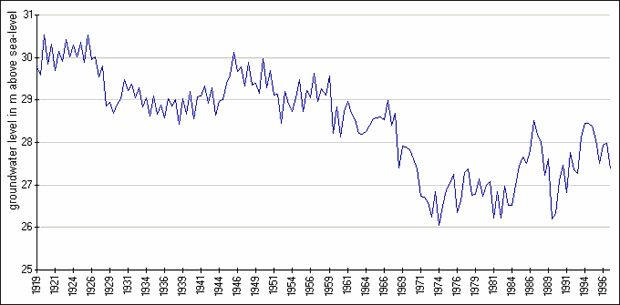In the following period, from the beginning of the 50’s to the beginning of the 80’s, the groundwater level sank continually and over large areas because of increasing withdrawals. This trend was particularly noticeable in water production areas (waterwork facilities). This lowering was caused by the general rise in water consumption by private households, and by construction (the rebuilding of the heavily destroyed city, subway construction, and massive construction projects). The expansion of water production facilities in West Berlin waterworks was completed by the beginning of the 70’s. The enlargement of the Friedrichshagen Waterwork in East Berlin began in the mid-70’s to supply water to the new residential areas in Hellersdorf, Marzahn and Hohenschönhausen.
A slight rise of groundwater levels has occured in West Berlin since the end of the 70’s.
A range of reasons can be given for this rise: smaller withdrawals from private wells; smaller withdrawals at construction sites (smaller construction volume and enforcement of groundwater returns); smaller withdrawal volumes of public waterworks; and, not least, effective man-made groundwater recharging (cf. Map 02.11).
Following the political changes in 1989 (fall of the Berlin Wall), the level of water consumption in the eastern boroughs of Berlin was drastically reduced, and the production at the waterworks in those areas fell an estimated 50 %. This resulted in the rise of the groundwater level throughout the city, east and west. Those areas nearest to waterworks recorded level increases as high as 3 m. The Berlin Pleistocene Watercourse, which covers half the area of the city, anyway has a very low depth to groundwater of only a few meters. Many of the cellars in some areas were not constructed according to code, therefore the sudden increase in groundwater caused major damage from flooding. In two areas, the damage was so extensive that it was necessary to implement groundwater regulatory measures. In Rudow within the catchment area of the Johannisthal Waterwork the groundwater level was lowered by a well gallery. Near the Kaulsdorf Waterwork, it is planed to regulate the groundwater by
lowering the lake level in the Kaulsdorfer Seen (lakes).
Permanent, wide and deep cones of depression have formed in water catchment areas around waterwork extraction wells. The considerable differences seen among the groundwater levels are directly related to variations in extraction demands at the waterworks. Riemeistersee (see=lake) and Nikolassee were dried out by water withdrawals of the Beelitzhof Waterwork at the beginning of this century. The groundwater level at Schlachtensee fell by 2 m, and at Krumme Lanke by 1 m. Water from the Havel has been pumped into the Grunewaldseen (inversion of natural flow) to balance this loss since 1913. The wetlands of Hundekehlefenn, Langes Luch and Riemeisterfenn, as well as the shore areas of the lakes were saved by this measure.
The cones of depression around well galleries at the Havel Lake have effects deep into the Grunewald (forest). The groundwater level at Postfenn sank 3.5 m between 1954 and 1974, and at Pechsee in Grunewald about 4.5 m between 1955 and 1975. Well gallery withdrawals at banks of the Havel cause severe drying of root soils of plants in the direct vicinity of the Havel.
About 90 % of the wetlands around the Müggelsee in southeast Berlin are threatened (Krumme Laake, Müggelheim, Teufelsseemoor, Neue Wiesen/Kuhgraben, Mostpfuhl, Thyrn, the lower course of Fredersdorfer Fliess).
Some wetland areas were flooded and given seepages of surface water to moderate negative effects caused by lowering of groundwater levels. These were the West Berlin nature reserves Grosser Rohrpfuhl and Teufelsbruch in the Spandau Forest, and Barssee in Grunewald; in East Berlin, Krumme Lake in Grünau and Schildow in Pankow.
Large-area lowering of groundwater levels occured in the Spandau Forest also, caused by the higher withdrawals by the Spandau Waterwork since the 70’s. A groundwater recharge plant, operated since 1983, percolates purified Havel water in an attempt to gradually raise groundwater levels. The groundwater level in the Spandau Forest was raised an average of 0.5 – 2.5 m by May, 1987. Groundwater recharge in this area has been restricted again because water appeared in cellars of near-by residential areas. The simultaneously rising withdrawal amounts of the Spandau Waterwork lowered the groundwater level again since 1990. In the following period, the groundwater level rose once more, due to the further reduction of withdrawal amounts.



